. Yamata no orochi 山田の大蛇 huge monster serpent .
:::::::::::::::::::::::::::::::::::::::::::::::::::::::::::::::::::::::::::::::::::::::::::::::::::::
Kagura Dance 神楽
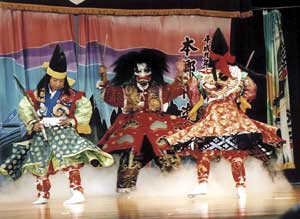
http://web-japan.org/kidsweb/master/kagura/1-art01.html
Kagura Dance and Music are part of the Shinto Rituals for the Gods, relating to ancient legends and were performed by priests and shrine maidens.
Now in some rural areas it is counted as a form of local art (minzoku geinoo) and preformed by the villagers themselves during the annual shrine festival. Some are are more like festive folk-drama. The area of Chichibu is especially known for its local kagura.
Some performances last more than one day. Even children perform in local kagura performances (kodomo kagura 子供神楽).
Masks made from Japanese paper (washi) are used and most old costumes are very precious.
There are various kagura types throughout Japan, see below.
:::::::::::::::::::::::::::::::::::::::::::::::::::::::::::::::::::::::::::::::::::::::::::::::::::::
The Mikagura 御神楽 style of Shinto is also known as kagura and is very similar to the court music of gagaku. The original dance was performed by the goddess Ama no Uzume no Mikoto to entice out the sun goddess into the world.
With time, Buddhist song-texts were introduced and the hichiriki, kagurabue, wagon and the shakubyoshi all came to be the instruments routinely used to accompany the songs. Only fifteen songs out of the repertoire are now performed and generally last about seven hours. The present performance tradition dates from the Meiji times.
The all male singers are divided into two groups; the motokata and the suekata, each with its own set of songs and a principal singer who accompanies himself on the shakubyoshi until the other singers and instruments enter at a point known as tsukedokoro. The song texts include some of the oldest known Japanese poetry.
The style is in general slow and solemn with the voice pure and unembellished. The notation is a system of neumes known as hakase, modelled on the notation for Buddhist chant, dating from the 12th century. The sumifu system has been in use since Meiji.
The Satokagura 里神楽 style of Shinto is distinct from the court kagura and instead features older ritual styles similar to that performed at Shinto shrines. This style of music involves the preparation of a shinza or place of worship to which the gods are invited. A priestess or miko is central to the ritual which is generally performed on winter evenings.
Satokagura can be subdivided into groups. One of the groups, Izumo kagura 出雲神楽, occurs throughout Japan, especially in the West and its main features are a series of dances performed with torimono (various ritual objects held by the dancers), followed by a noh play.
Another group, Ise kagura 伊勢神楽 is found in Kyoto and in the North and involves a ceromony known as yutate in which warm or boiling water is sprinkled about.
Edo kagura 江戸神楽 is found in Eastern Japan, especially Tokyo and is similar to Izumo kagura but is also influenced by mibu kyogen (a type of Buddhist morality play).
Other sub-groups include the Shishikagura 獅子神楽 which includes a lion dance (shishi-mai) and is now found in many forms throughout Japan and Yamabushi kagura 山伏神楽 which was originally performed by mountain ascetics. It embodies the eclectic, folk religious worldview of the Shugendo tradition.
With time, Satokagura took on a more theatrical form when special dance-halls were built especially for this style known as kaguradono. Accompanying instruments are generally found to be stick drums and transverse flutes. The rhythms are strong and lively.
http://www.digital-daydreams.com/enc/world/show_country.php?id=32
:::::::::::::::::::::::::::::::::::::::::::::::::::::::::::::::::::::::::::::::::::::::::::::::::::::
Iwami Kagura 石見神楽
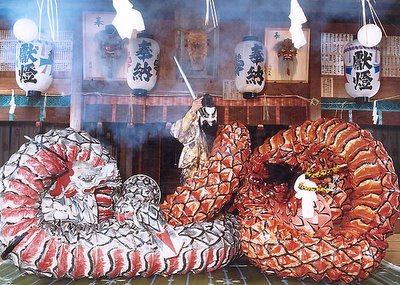
As a result of the evil deeds of her brother Susano-wo, the sun-goddess Amaterasu-omikami hid herself in the Cave of Heaven.
Susano, having been chased from Heaven, wandered across the continent of China until he crossed into the land of Izumo (modern Shimane prefecture) and came to the River Hi, where he met Princess Inada and an old couple wailing and lamenting.
When Susano asked why they were so upset, he was told that every year the terrible eight-headed serpent Yamato-no-Orochi appeared, and that it had already devoured seven of their daughters and would soon come to take their remaining child, Princess Inada. Susano soon formulated a plan and made the Orochi drink some poisoned sake brewed from various nuts, and then killed it whilst it was drunk.
He then recovered from the monster’s tail a sword that he named Ame-no-murakumo-no-tsurugi (Treasure Sword of Heaven) and presented it to his sister Amaterasu. He then married Princess Inada.
http://www.city.hamada.shimane.jp/en/kagura/orochi.htm
:::::::::::::::::::::::::::::::::::::::::::::::::::::::::::::::::::::::::::::::::::::::::::::::::::::
Miko Kagura 巫女神楽
a traditional dance in honour of the gods, performed by the maidens and priestesses (miko) of a shrine. Also called Miko Dance (miko mai 巫女舞).
:::::::::::::::::::::::::::::::::::::::::::::::::::::::::::::::::::::::::::::::::::::::::::::::::::::
Orochi Kagura, performed in the Izumo area
Orochi is a giant serpent which threatenes the local population. Yamata no Orochi (八岐大蛇、八俣遠呂智、八俣遠呂知 ー ヤマタノオロチ), a Serpent with eight heads is killed by the Deity Susa-no-O (Susano)、as we have seen in Iwami Kagura.
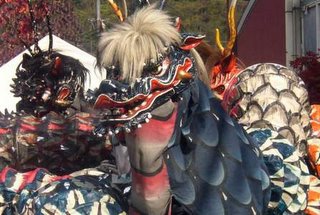
© Jake Davies / http://www.japanvisitor.com/ikj/ji/242.html
. Yamata no Orochi 八岐の大蛇 Serpent with eight heads .
papermachee figures from Tottori
:::::::::::::::::::::::::::::::::::::::::::::::::::::::::::::::::::::::::::::::::::::::::::::::::::::
Matsumae Kagura 松前神楽, Hokkaido
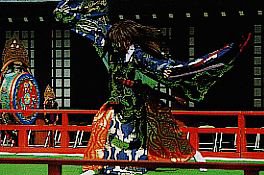
The kagura style of dance and music is performed in the course of worshiping Shinto gods and this type of performance is best represented by the Matsumae kagura. It is believe to have been performed first in 1674 at Matsumae castle, formerly Fukuyama, being officially appointed to Lord Norihiro, the 6th head of the Matsumae clan.
Kagura of this style is performed mainly at shrines in the south of Hokkaido. The fact that the Matsumae Kagura is traditionally performed and transmitted by the Shinto priests alone has contributed to the refinement of its artistry. Among the kagura dances performed by ordinary people is the Sanjo Kagura which is a variation of the kagura from Hachimangu Shrine in Sanjo city in Niigata prefecture.
Also known as Dai Dai kagura, this particular style of performance was adopted by the Hokkaido Shrine, the Sumiyoshi Shrine in Otaru, the Muroran Hachiman Shrine, the Nopporo Shrine and the Takikawa Shrine among others, though kagura is no longer performed at the Takikawa Shrine.
Kagura of this sort was developed after the settlers who came from the Sanjo area invited performers of ancient court music from their town of origin to dedicate their performance to the shrine. The Dai Dai kagura is performed by ordinary people of the community unlike the Matsumae Kagura which is performed by priests.
http://www.pref.hokkaido.jp/kseikatu/ks-bsbsk/digest/chapter_9.html
dai dai kagure, daidai kagura ダイダイ神楽 / 太太神楽 / 太々神楽
:::::::::::::::::::::::::::::::::::::::::::::::::::::::::::::::::::::::::::::::::::::::::::::::::::::
Dai Kagura, Daikagura 太神楽 Edo Daikagura
Dai Kagura is a remnant of the activities of Shinto dance troupes in the Edo Period, who brought Kagura (God-Music) performances to the local people who could not worship at Ise Shrine. The troupes who traveled around Western Japan throughout the year gathered on annually on the afternoon of December 24 at the Masuda Shrine of the main actor to perform all their acts as offerings.
The performers used some special words with different meanings, for example:
fukareru - to be turned down
gomui - bad
gosha, go sha - five yen
hitotsubo - 1,8 liter, 1 sho
mochi - police
mokoi - good
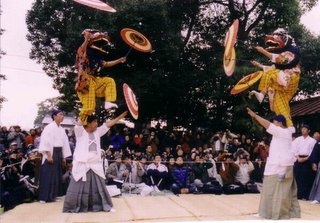
source : 2005. Mie Prefecture
ooooooooooooooooooooooooooooooooooooooooo
- quote -
What is “Edo-Daikagura”? Who is Senmaru?

Senmaru is a performer of “Edo-Daikagura”. “Edo” is an old name of Tokyo. “Daikagura”, it is very difficult to explain it.
Reportedly, the original purpose of Daikagura was to serve as a talisman for the people, chasing away evil on behalf of Jingu (the grand Shintoism shrines). Thus, Daikagura was originally a very sacred and serious performance. Today, the performance is becoming people’s entertainment. Senmaru wears a “kimono” and performs Japanese traditional tricks.
- source : senmaru.info/english... -
ooooooooooooooooooooooooooooooooooooooooo
太神楽(だいかぐら)は古くより神社に伝わる「伎楽(ぎがく)・散楽(さんがく)」の一部で、伊勢神宮・熱田神宮の二ヶ所が発祥の地と伝えられています。
江戸開府と共に出府し、獅子舞を連れて氏子の家々を廻りお祓いをする風習が生まれました。神様に代わって悪魔祓いの獅子舞を演じたことから、代神楽(だいかぐら)とも呼ばれていました。
神様への「奉納」・氏子への「祈祷」等が主な内容だった太神楽は、寄席の出現に伴い「神事芸能」から「舞台芸能」へと変化をし、獅子舞の余興として演じていた曲芸は大衆への娯楽を提供する「寄席芸能」へと発展してきました。
江戸時代に始まったこの「太神楽曲芸」は、明治・大正・昭和と時代に合わせた技を取り入れ、平成の今へと受け継がれている伝統芸能です。
太神楽は「舞」・「曲芸」・「話芸」・「鳴り物」の四つの柱から成り立っています。
http://www.daikagura.jp/kaisetsu.html
:::::::::::::::::::::::::::::::::::::::::::::::::::::::::::::::::::::::::::::::::::::::::::::::::::::
Locating Transcendence in Japanese Minzoku Geinô:
Yamabushi and Miko Kagura
Lisa Kuly
Cornell University, Ithaca, New York 2003
Contemporary minzoku geinô (minzoku geinoo, folk performing arts) in Japanese society is associated with the matsuri, or festival. Community members, such as workers and students, practise and perform various types of minzoku geinô in preparation for local festivals.
However, a look at the history of minzoku geinô reveals that originally its practitioners were marginalized members of society, who used ecstatic expression to perform various rites such as healings, exorcisms, and blessings.
Furthermore, the attitude toward ritual specialists was often negative; indeed, shamanistic practices were prohibited during the Meiji period (1868-1912). In response to social attitudes, ecstatic performers of Japan's premodern period negotiated their expressive powers in a variety of ways in order to survive.
This paper introduces the reader to the typology of minzoku geinô that involves ecstatic performance presented by yamabushi, male mountain-dwelling ascetics, and miko, female shamans generally associated with Shinto shrines. Moreover, the discussion in this paper illustrates how ecstatic performance changed throughout history to the extent that it is now seldom performed by marginalized ritual specialists.
Performers of contemporary minzoku geinô are accepted members of society. Furthermore, both the performers and the audience of minzoku geinô are affected by the transformative nature of ecstatic expression.
http://www.fl.ulaval.ca/celat/acef/kulya.htm
:::::::::::::::::::::::::::::::::::::::::::::::::::::::::::::::::::::::::::::::::::::::::::::::::::::
- - - - - Further Links in the Daruma Museum:
. Mask of Ko-Daruma for Satokagura
小だるまの面
. Kagura at Kirishima Shrine 霧島神宮 .
Kagura, by Kids Web Japan
Iwami Kagura 石見神楽
Tengai : Canopy and Iwami Kagura
Musical Instruments (01)
:::::::::::::::::::::::::::::::::::::::::::::::::::::::::::::::::::::::::::::::::::::::::::::::::::::
source : edoichiba menutisyoku
menuchi shokunin 面打職人 craftsmen making masks
They make masks for 神楽面 Kagura dance and 能面 Noh performances.
The wood used most often is kusunoki 楠 camphor, hinoki 檜 cypress and kiri 桐 paulownia.
. Edo no shokunin 江戸の職人 Edo craftsmen .
:::::::::::::::::::::::::::::::::::::::::::::::::::::::::::::::::::::::::::::::::::::::::::::::::::::
Other Links
神話と里神楽の神々 (非常に詳しい資料)
神楽は神遊びともいい、
宮廷で神を祭る際の舞楽で、もつぱら神前で奏する音楽。 天宇受売命を遠祖とする猿女が代々伝えてきた。
これ対する一般の神楽を里神楽という。
九州 : 日向神楽、佐伯神楽、平戸神楽。
中国・山陰・山陽 :
大社神楽、佐陀神楽、備前神楽。
四国 : 伊予神楽。
近畿・中部 : 巫女神楽、花祭り。
関東 : 里神楽、岩戸神楽。
東北 : 番神楽、山伏神楽。
北海道 : 松前神楽。
http://www.asahi-net.or.jp/~pq7s-nsmr/nof_shinwa.htm
子供神楽, 写真がいっぱい
Childrens Kagura with many photos
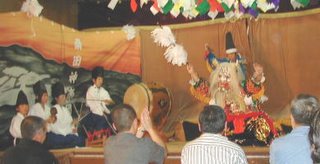
From 2000
http://ww3.enjoy.ne.jp/~ahmsm.kuwata/child/child.html
:::::::::::::::::::::::::::::::::::::::::::::::::::::::::::::::::::::::::::::::::::::::::::::::::::::

KAGURA as a kigo for haiku !
:::::::::::::::::::::::::::::::::::::::::::::::::::::::::::::::::::::::::::::::::::::::::::::::::::::
[ . BACK to WORLDKIGO . TOP . ]
[ . BACK to DARUMA MUSEUM TOP . ]
- #kagura #daikagura #daidai -
:::::::::::::::::::::::::::::::::::::::::::::::::::::::::::::::::::::::::::::::::::::::::::::::::::::










18 comments:
Thank you Gabi! You have helped me identify the Shiraishi Island kagura as the Iwami style. It certainly is a beautiful performance to watch.
Hi Gabi
Thank you for a wonderful introduction to Kagura nationwide. You might be interested to know that I've recently published a book on Izumo Kagura based on my experiences over four years with troupes in Hiroshima and Shimane. "An Invitation to Kagura: Hidden Gem of the Traditional Japanese Performing Arts" is available at most online bookstores.
Cheers
Dr. David Petersen
lulu.com/lang-arts
やぶ入やきのふ過たる山神楽
yabuiri ya kinoo sugitaru yama-kagura
home for a day --
the Hachiman shamans
danced yesterday
Issa
Tr. and comment by Chris Drake:
http://washokufood.blogspot.jp/2008/01/new-year-food.html
.
座布団を積みて神の座里神楽
zabuton o tsumite kami no za sato-kagura
the seating cushions
are piled up high at the divine seat -
Kagura dance in the village
Morio Akiko 盛生晶子
MORE
about kami no za
.
Sakurado Yakushi 桜堂薬師 / 櫻堂薬師
瑞浪市土岐町桜堂 / Sakuradō Tokichō Mizunami-shi, Gifu
.
奈良時代中国の唐から伝来した舞楽に使う面だそうです
Kagura masks from China
.
- daija, orochi 大蛇 the huge serpent, great snake -
A huge snake demon monster. He impersonates the ike no nushi 池の主 Master of the Pond
and asks for human sacrifices.
Sometimes a kappa in the form of a snake is seen as the "Master of the Pond" too.
and
. Legends about ike no nushi 池の主 と伝説 the Master of the Pond
Der Herr des Teiches .
Yamata no Orochi
Matthew Meyer
Today’s yokai is really fun because not only is it imposing and awesome, but it is one of the rare creatures with a longer legend behind it, instead of simply a few sentences in one of Toriyama Sekien’s books. But first, an interesting question: what exactly is a yokai?
I ask this because invariably, when a famous creature like Yamata no Orochi, or kirin, or tatsu, etc. are brought up, someone is going to say, “I thought XX was a bakemono, not a yokai!” or “Wow, XX is a yokai? I had no idea!”
It’s a strange question, because how do we really classify made-up creatures? Where is the line between yokai and yurei, or yokai and kaiju, or even yokai and monster? And even though it seems strange to pick nits over imaginary creatures, it is something that we have been doing for a long time—at least as long as we have been classifying real creatures! Even back when Toriyama Sekien was writing his books, he was developing something like a Linnaean taxonomy for them.
Generally, if you ask any number of yokai-ologists (is that a thing??) to define a yokai, you will get as many definitions as you have people. Most of the time, the similarities are just too vague to truly iron out. One story might seem to draw a clear distinction between certain characteristics of a particular yokai, but then another story might blow those distinctions to pieces.
For example, some people might argue that a kirin is a kami, not a yokai… but then in some places, kappa and hyosube (to name a few) are worshiped as kami and even have their own shrines. Does that mean kappa are kami as well? Many ghosts are also worshiped as kami, such as the famous Tenjin-sama, who is the god-version of the yurei Sugawara no Michizane. So is he not a yurei? Some might say that yurei are the spirits of people, but then are onibi ghosts or yokai or something else? The vagaries are endless, and it becomes impossible to pin down a truly authoritative definition.
And then, of course there are the similar terms bakemono, mamono, mononoke, and so on… where does it end?
...
http://matthewmeyer.net/blog/2015/10/07/a-yokai-a-day-yamata-no-orochi/
.
Kobayashi Issa
はつ雪やとある木陰の神楽笛
hatsu yuki ya toaru kokage no kagura-bue
first snow -
In the shade of trees
the Kagura dance flute
.
kagura dance - introduction
Hikosan odori 彦山踊 / 英彦山踊り Hikosan dance
In the Kamitsuno and Shimotsuno settlements in Soeda Machi, the "Tsuno Kagura" is dedicated for the Jinko-sai (Jinko festival) held by Takagi Shrine at the beginning of May every year.
Hikosan 英彦山 / 彦山 Hikosan Shrines, Fukuoka and Oita
Kobayashi Issa
はつ雪やとある木陰の神楽笛
hatsu yuki ya toaru kokage no kagura-bue
first snow!
beneath a tree
a sacred flute
In Issa's time a form of sacred dancing called kagura (possibly meaning "divine storehouse") was commonly performed, mainly by female shamans.
read the comment by Chris Drake
.
https://groups.yahoo.com/neo/groups/translatinghaiku/conversations/messages/5042
.
Tengu masks and Kagura
Tengu no men 天狗の面 mask of a Tengu
.
Hayachine Kagura 早池峰神楽 ( Hanamaki City ) Iwate
Kagura Dance Masks from Hayachine 早池峰神楽面
.
http://omamorifromjapan.blogspot.jp/2016/12/hayachine-iwate.html
.
Kagurazaka - Kagurasaka 神楽坂 "Slope of the Music of the Gods"
Ushigome Kagurazaka 牛込神楽坂
Shinjuku, Tokyo
.
https://edoflourishing.blogspot.jp/2017/03/yarai-district.html
>
Buzen Kagura 豊前神楽 Mask
.
https://omamorifromjapan.blogspot.jp/2011/09/masks-men-info.html
.
bangaku 番楽
is the local word in Akita and Yamagata for 山伏神楽 the Kagura dance of the Yamabushi mountain priests.
It has kept many old traditions.
.
https://fudosama.blogspot.jp/2017/10/fudo-legends-10-wakayama.html
.
Suzukayama Shinmai 鈴鹿山新舞 new Kagura Dance of Suzukayama
performed in Hiroshima
.
https://gokurakuparadies.blogspot.jp/2018/04/butsusen-04-suzuka-okina.html
.
Legend from Kagawa, 内海町 Utsumicho town
daidai kagura ダイダイ神楽 Dai Dai Kagura
At 小豆島 Shodoshima island the Daidai Kagura from the Shrine of Ise 伊勢 comes around the island to purify each home.
But since the beginning of the Meiji period around 1890 it was thought of as improper and stopped. But in this year in all villages an epidemic broke out. They said it was because they stopped the Kagura dance and from next year on, they performed it again.
.
https://heianperiodjapan.blogspot.com/2020/02/hayariyamai-epidemic-legends.html
.
Legend from 耶麻郡 Yama district 高郷村 Takasato village
.
If the shishigashira 獅子頭 lion head hears the sound of water, it wants to get out of its box.
Usually the sound of water is drowned by the drums and flutes during the festival.
One day the villagers were drunk during the festival and forgot about this.
They passed by a waterfall.
The lion head heard the sound of water and got out of the box, jumping into the waterfall.
Since then this is called the 神楽滝 Kagurataki Waterfall (Kagura Dance Waterfall).
.
photo
https://heianperiodjapan.blogspot.com/2020/04/shishigashira-legends.html
.
Post a Comment